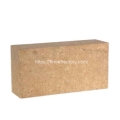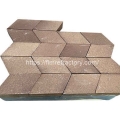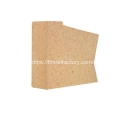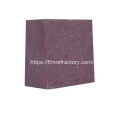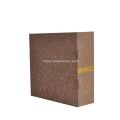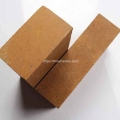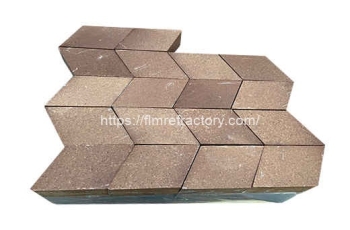- Performance. Innovation. Worldwide. Your trustworthy Refractories Manufacturing Partner--Fireramo
- +86 175 3769 7777
Magnesia Spinel Brick
- Category: Magnesia Brick
- |
- Author: Fireramo
We offer high quality magnesia spinel bricks for wholesale and sale at factory price. Inform us your requirements, you can also get customized magnesia spinel bricks service.
- Origin: China
- Product Name: Fireramo Magnesia alumina spinel brick
- OEM/ODM: Support
- Refractoriness (℃): 1770< Refractoriness< 2000
- Feature: Long Time Materials
- Type: Refractory Material
- Material: Magnesia Spinel Brick
- Bulk Density: ≥2.85g/cm3
Search
Contact
High quality refractory bricks
Product Details
Magnesia Spinel Brick for Sale
Description
Magnesia spinel brick is an excellent high temperature refractory brick with excellent refractory properties and chemical stability. Magnesia spinel refractory bricks are widely used in high-temperature equipment and refractory components in metallurgy, chemical industry, glass, ceramics and other industries.
Fireramo has Magnesia Aluminum Spinel Bricks, Magnesia Iron Spinel Bricks, and Magnesia Alumina
Zirconium Bricks.




Features
High temperature resistance
Magnesia spinel bricks are stable at high temperatures, typically withstanding temperatures up to 1700 degrees Celsius (3092 degrees Fahrenheit). This makes them suitable for use in high-temperature industrial equipment such as metallurgical furnaces and glass kilns.
Fire resistance
Magnesia spinel bricks are highly refractory and can withstand thermal stress and thermal shock at high temperatures. They are able to withstand rapid temperature changes without cracking or damage.
Chemical stability
Magnesia spinel bricks have a high resistance to acids, alkalis and other chemicals. This makes them widely used in corrosive environments in the chemical and metallurgical industries.
Mechanical Strength
Magnesia spinel bricks have high mechanical strength and compressive capacity, and are able to maintain their structural integrity at high temperatures and under mechanical stress.
Low thermal conductivity
Magnesia Spinel bricks have a low thermal conductivity, which reduces heat conduction and heat loss.
Low coefficient of expansion
Magnesia Spinel bricks have a low coefficient of expansion, which reduces the risk of thermal stress and thermal cracking during temperature changes.
Good thermal conductivity
Magnesia Spinel bricks have high thermal conductivity and are able to conduct and disperse heat efficiently. This is beneficial for applications that require rapid and even heating or heat dissipation.
Lightweight
Compared to some other refractories, magnesium spinel bricks have a lower density and lighter weight, making them easier to design and install during the process.
Ease of processing
Magnesia Spinel bricks have good machinability and can be cut, drilled, ground and other machining operations to suit different sizes and shapes.
Application
Iron and steel smelting
In the process of iron and steel smelting, magnesium-aluminum spinel bricks have a wide range of applications, and can be used in different parts of the furnace, furnace throat, cooling wall, etc. The most common application is in the steel smelting process. Among them, the most common application is in the body and roof of the steel converter to ensure the safe and stable operation under the high temperature environment in the steel production process.
Cement Manufacturing
In the cement manufacturing process, magnesium-aluminum spinel bricks can be used in different equipments such as rotary kilns, preheaters, coolers, etc. to ensure the reliability and stability of their long-time operation under high-temperature conditions.
Glass melting
In the process of glass melting, magnesium-aluminum spinel bricks can be used in the melting kiln and its ancillary equipment, the bottom pool and other parts to ensure the quality of glass melting and production efficiency.
Magnesia spinel bricks are used in aluminum liquid treatment equipment, such as aluminum liquid stirring furnace, aluminum liquid cladding furnace and aluminum liquid stirring cladding furnace. They are able to withstand aluminum liquid erosion and mechanical stress at high temperatures.
Chemical industry
Magnesia spinel bricks are used in chemical equipment such as chemical reactors, furnace chambers, chimneys and heat exchangers. They are able to withstand erosion by corrosive media such as acids and alkalis and provide excellent refractory properties.
Magnesia Spinel Brick Specifications
| Magnesia Spinel Brick | Magnesia Alumina Spinel Brick | Magnesia Alumina Spinel Zirconium Bricks | Magnesia Alumina Zirconium Bricks | ||||||||
|---|---|---|---|---|---|---|---|---|---|---|---|
| MgO% | ≥ | MLJ-85A | MLJ-93A | MLJ-95A | MLJ-85B | MLJ-93B | MLJ-95B | MLJZ-93A | MLJZ-93B | MZ-96A | MZ-94B |
| Al2O3 | ≥ | 92 | 88 | 92 | 88 | ||||||
| Fe2O3 | ≤ | 85 | 88 | 93 | 82 | 85 | 90 | 5 | 5 | 5 | 5 |
| SiO2 | ≤ | 9 | 5 | 3 | 9 | 5 | 3 | 0.7 | 0.8 | 0.8 | 0.9 |
| ZiO2 | ≥ | 0.7 | 0.7 | 0.7 | 0.8 | 0.8 | 0.8 | 1 | 2.5 | 1 | 2.5 |
| Apparent Porosity | ≤ | 0.6 | 0.8 | 0.7 | 2.5 | 2 | 2.5 | 44929 | 44929 | 44929 | 44929 |
| Bulk Density | ≥ | – | – | – | – | – | – | 17-18 | 17-18 | 17-19 | 17-19 |
| Cold Crushing Strength | ≥ | 16-18 | 16-18 | 16-18 | 17-18 | 17-18 | 17-18 | 2.85 | 2.8 | 2.9 | 2.8 |
| 0.2.Mpa Refractoriness Under Load(℃) | ≥ | 2.85 | 2.85-3.0 | 2.85 | 2.8 | 2.85 | 2.82 | 50 | 50 | 50 | 45 |
| Thermal Expansion 1400℃ | 45 | 45 | 45 | 40 | 40 | 40 | 1700 | 1660 | 1700 | 1650 | |
| Thermal Shock Resistance | 1100℃ water cooling, times | 1700 | 1700 | 1700 | 1700 | 1700 | 1700 | 1.6 | 1.6 | ||
| 950℃ water cooling, times | – | 12 | 10 | 8 | 6 | ||||||
| Heat Conductivity | 12 | 12 | 12 | 10 | 10 | 10 | 100 | 80 | 30 | 25 | |
| 100 | 100 | 100 | 80 | 80 | 80 | 3 | 2.9 | 4.5 | 4.4 | ||
| 2.8 | 2.9 | 3 | 2.8 | 2.9 | 3 |
Specializing in refractory materials for over 20 years, we provide professional refractory solutions for the global high temperature industry.
Theme By Fireramo
